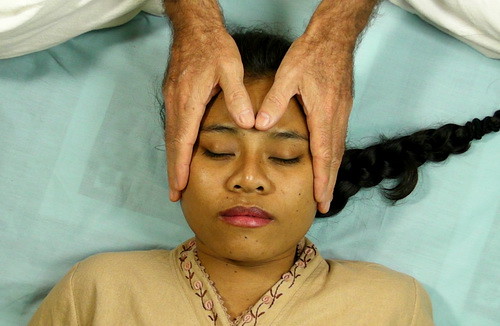What Is Traditional Thai Massage?
Traditional Thai massage, often called “yoga for the lazy,” is an ancient healing practice blending acupressure, assisted yoga-like stretching, and rhythmic compression techniques. This deeply therapeutic massage targets energy lines, known as “sen,” to unblock flow and renew the body’s vitality.
Key components include precise acupressure using thumbs, palms, and elbows, combined with slow, guided stretches that increase flexibility and ease muscle tension. Some therapists also use their feet to apply deep pressure for lasting muscle relief. This comprehensive approach promotes better circulation, relieves pain, boosts energy, and enhances mental calmness. Discover more about this holistic therapy below.
Key Techniques in Traditional Thai Massage
Acupressure Therapy
Therapists use acupressure to stimulate specific points along the body’s energy pathways or “sen” lines. Employing thumbs, palms, and elbows, they apply varied pressure to dissolve blockages and release tension, enhancing overall relaxation and energy flow.
Assisted Yoga and Stretching
Often called “lazy man’s yoga,” this technique involves the therapist guiding the client through gentle stretches similar to yoga poses. These assisted stretches improve flexibility, relieve muscle tightness especially in hips, legs, and back, and boost joint mobility.
Rhythmic Compression
Distinct from Western massage techniques, rhythmic compression involves pressing and holding various muscle groups in a steady rhythm. This boosts blood circulation and aids in releasing chronic muscle tension and stiffness.
Foot and Back Techniques
In some sessions, therapists use their feet to apply strong, controlled pressure on the back and thigh muscles. This method benefits large muscle groups, promoting deep compression that alleviates tightness and enhances muscle recovery.
Benefits of Traditional Thai Massage
Traditional Thai massage offers numerous physical and mental benefits, including:
- Improved Blood Circulation
Rhythmic compression and stretching encourage enhanced blood flow, delivering more oxygen and nutrients to muscles and tissues. - Muscle Relaxation and Pain Relief
Deep pressure techniques help release chronic muscle tension and reduce pain, promoting overall relaxation. - Enhanced Flexibility and Range of Motion
Assisted yoga-like stretches improve joint mobility and muscle elasticity, making it ideal for relieving tightness and stiffness. - Increased Energy Levels
By unblocking energy pathways, traditional Thai massage revitalizes the body and boosts vitality. - Mental Calmness and Stress Reduction
The combination of mindful acupressure and meditative breathing reduces stress, anxiety, and mental fatigue.
Experiencing a Traditional Thai Massage: What to Expect
Preparation and Setting
Sessions typically begin with changing into loose, comfortable clothing provided by the spa. At reputable locations such as reputable spa, you can expect a clean, relaxing environment with professional therapists certified in authentic Thai massage techniques.
Acupressure and Stretching
The therapist generally starts with acupressure on the feet and gradually works up the body, loosening muscles and stimulating energy flow. Following this, assisted stretches are performed to enhance flexibility and release deep muscular tension.
Customization for Individual Needs
Experienced therapists tailor each session based on your body’s unique needs, focusing on specific tension areas or preferences regarding pressure strength and stretch intensity.
Finding the Best Traditional Thai Massage in Phuket
Phuket is renowned for its authentic Thai massage offerings. Choosing a spa in Phuket means access to skilled therapists and genuine experiences. When selecting a spa, look at therapist certifications, hygiene standards, and customer reviews to ensure a premium, authentic treatment such as those offered at best traditional Thai massage in Phuket.
Choosing a Reputable Spa
Select spas that employ certified therapists trained in traditional Thai massage. Reliable spas prioritize customer safety, cleanliness, and authenticity to deliver a superior experience.
Essential Tips for Your Thai Massage Experience
- Communicate Your Preferences: Clearly inform your therapist about your preferred pressure and any areas needing special attention.
- Breathe Deeply and Relax: Deep, mindful breathing enhances relaxation and increases the effectiveness of the massage techniques.
- Stay Hydrated: Drink plenty of water after your session to help flush out toxins and aid muscle recovery.
Why Traditional Thai Massage Stands Out
Traditional Thai massage is more than just muscle relief—it offers a comprehensive mind-body healing experience. The integration of acupressure, stretching, and meditative breathing techniques make it uniquely effective for people with busy, stressful lifestyles seeking deeper rejuvenation.
Choosing the Best Package for Your Needs
Many spas provide various massage packages, including combinations with foot reflexology or head massages alongside traditional Thai massage. Explore your options to find the perfect blend that meets your wellness goals.
Conclusion
Experiencing an authentic traditional Thai massage is a holistic journey into relaxation, flexibility, and well-being. Through expertly applied acupressure, assisted yoga stretches, and rhythmic compression, this timeless therapy leaves you physically rejuvenated and mentally refreshed. Embrace this healing art to reconnect with your body and achieve lasting health benefits.
Frequently Asked Questions (FAQs)
Typically, you will wear loose, comfortable clothing provided by the spa, allowing full movement during assisted stretches and massage.
Sessions usually range from 60 to 120 minutes, depending on your preference and package selection.
While it is generally safe, individuals with certain medical conditions, such as heart problems or recent surgeries, should consult their healthcare provider before getting a Thai massage.
The pressure varies according to your comfort level. Communicate openly with your therapist to adjust pressure and ensure a relaxing experience.
Frequency depends on individual needs. For maintenance and stress relief, once a month may suffice; those with chronic tension might benefit from weekly sessions.



